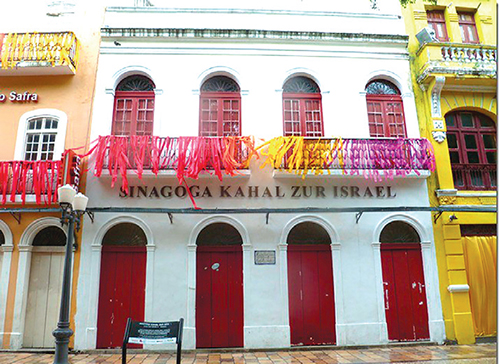

When we traveled to Brazil, we had a lot to learn, especially about Recife—the easternmost city in Brazil and center of the slave trade way back when the Portuguese brought African slaves to the Americas to work on sugar plantations. It is also the city from which the Jews fled to New Amsterdam in 1654 when the Portuguese Inquisition began the New World.
Recife is unique in Brazil in that, geographically, Recife is closer to Senegal in Africa than to the southernmost tip of Brazil. (Recife is also the city where the Trans-Amazon Highway begins, an incredibly ambitious project undertaken by the Brazilian government to build a highway from Recife in the east and across the Amazon region to the western border of Brazil and eventually to the west coast of South America. The project was begun in the 1960s and has still not been completed, as each year sections of the highway are washed away by the Amazon River. But this is the story of the Jews of Recife and their short, yet prosperous, history.)
The story of Recife starts when the Spanish and Portuguese explorers ventured into the unknown and found the New World. Under the terms of the Treaty of Tordesillas, Spain ended up controlling virtually all of South America except for Brazil, which was owned by the Portuguese Crown. The Dutch, who originally came to Brazil, came not as explores or conquerors, but as merchant suppliers and chandlers, whose function was to supply goods to this Portuguese colony. Among them were Jews who fled the Spanish Inquistion for Turkey and Holland, where the merchants of the world plied their trades.
Although Brazil was a Portuguese colony, the Inquisition had not yet crossed the Atlantic, so in 1524, there was an active Dutch trade with Brazil and Jews were traders for the Dutch.
A group of Dutch Jews were then able to establish the first Jewish community in the Western Hemisphere in Recife, and established Kahal Zur Israel by 1536—the first shul in the Western Hemisphere. Dutch control lasted until 1654. In that short period of time the Jews prospered and owned six of the 120 sugar refineries in the area.
The Jews, of course, supported the Dutch, but the Dutch eventually lost. Under the Articles of Surrender, Jews were given three months to get out of Recife, but they were allowed to liquidate all their assets and take everything with them. It is estimated that at that time there were just under 2,000 Jews living there. Some returned to Holland, while others tried to get to New Amsterdam—which later became New York City. In 1654 they founded the Spanish-Portuguese Synagogue, Shearith Israel, in New York, where Rabbi Meir Soloveitchik is the pulpit rabbi today.
Before the Inquisition, Jews got on well with their neighbors, and some Jews even took up residency in the nearest town of Olinda, although the community’s center remained in Recife.
We were on a hill overlooking the ocean in a courtyard full of shops selling all kinds of souvenirs to tourists. In the middle of the courtyard we discovered the ruins of the mikveh that was used during the 1600s. In the intervening years it had been converted to something resembling a backyard pond, but archeological investigation confirmed it started out several hundred years ago as a ritual bath. The mikveh was considered so important by the Jewish community that when a new Jewish community was established, building the mikveh took precedence over building a shul. The presence of the mikveh in Olinda is clear evidence that a substantial number of Recife Jews lived “los burbas” (the burbs).
Kahal Zur Israel functioned where houses no. 197 and 203 Rua dos Judeus, once called “Street of the Jews” and today called Rua do Bon Jesus (“Street of Good Jesus”) stand today. The synagogue served a community of approximately 1,800 Jews. It had a cantor, Josue Velosino, and a rabbi, Isaac Aboab da Fonseca, who was sent to Recife in 1642. The original synagogue building survived until the early 20th century, when it was torn down. The site of the original synagogue has subsequently been confirmed by archaeological studies. In 2001 the decision was made to create a Jewish museum, with two shops located on the first floor of the two-story house then standing on the site of the old synagogue.
Today, there are four synagogues in Recife, but many Jews choose to celebrate their weddings and celebrations in Kahal Zur Israel because of its symbolism. The synagogue is also at the center of a broader cultural renaissance. In November of every year, a Jewish festival offering dance, cinema, and food attracts around 20,000 visitors.
Recife is where the Jewish history of the New World began, and it’s certainly worth a visit. But when you do, make sure you also take the short taxi ride to Olinda, to the top of the hill just outside Recife, with its mikveh and stone door lintels with niches carved out for the placement of mezzuzot, and imagine what life might have been like for the Jews who prospered in these seaside towns and suburbs of 17th century Brazil.
By Nina C. Friedman











